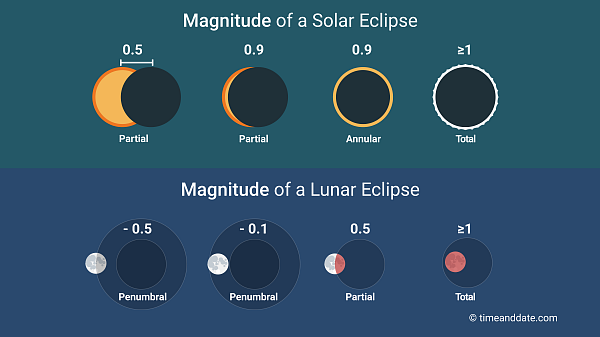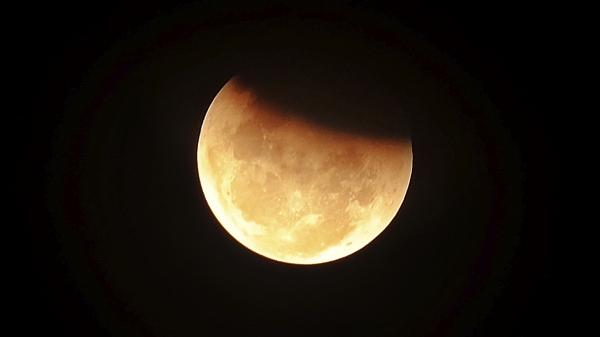What Does the Magnitude of an Eclipse Mean?
The magnitude of an eclipse is the fraction of the diameter of the disk of the eclipsed body that is covered by the eclipsing body.


Magnitude is a defining element of an eclipse.
October 2, 2024: A Micromoon annular eclipse
Fraction of the Sun's Diameter
- The magnitude of a solar eclipse is the fraction of the Sun's diameter covered by the Moon.
- The magnitude of a lunar eclipse is the fraction of the Moon's diameter covered by Earth’s shadow. Because Earth casts 2 different shadows–the umbra and the penumbra–there are 2 magnitudes associated with lunar eclipses: the penumbral magnitude and the umbral magnitude.
The value of the magnitude of an eclipse–solar or lunar–is typically expressed as a decimal fraction (e.g., 0.75).
Most scientific and astronomical outlets report the magnitude of an eclipse at the greatest, or maximum, point of the eclipse.
Magnitude of a Solar Eclipse
Annular or partial solar eclipses have a maximum magnitude of less than 1. For total solar eclipses, the value is 1 or greater.
The maximum magnitude of a hybrid solar eclipse changes depending on the location. Some observers along the central shadow's path see a total solar eclipse with a magnitude greater than 1 while others experience an annular eclipse, which has a magnitude below 1.
Higher Magnitude = Longer Totality

The magnitude of a partial eclipse is always less than 1.
©iStockphoto.com/Andy_Astbury
The higher the magnitude number (more than 1) of a total solar eclipse the longer the eclipse will last, and the area it can be seen from on Earth will be larger. Higher magnitudes also tend to give better views of the solar corona and of any planets or stars that may be visible. On the other hand, phenomena such as Baily's beads, the Sun's chromosphere, and shadow bands tend to be visible only for a short time during these types of eclipses.
When a total solar eclipse's magnitude is 1 or just slightly above 1, the eclipse has a shorter totality and is usually visible from a smaller portion of Earth. However, observers have an extended view of phenomena such as Baily's beads, the Sun's chromosphere, and shadow bands.
How Earth’s rotation affects eclipse paths
Imitating Total Eclipses
Annular eclipses that have a magnitude close to 1 tend to look like total solar eclipses–the skies get darker, the temperature can fall considerably, and phenomena that occur during a total eclipse can sometimes be observed.
Sights you can only see during totality
Lunar Eclipses Have 2 Magnitudes

The higher the umbral magnitude of a lunar eclipse, the darker the eclipse will be.
©iStockphoto.com/Petrusloo
There are 2 magnitudes associated with a lunar eclipse–an umbral magnitude and a penumbral magnitude. The umbral magnitude is the fraction of the Moon's diameter that is covered by Earth's umbra at the instance of the greatest eclipse.
A partial lunar eclipse has an umbral magnitude that is greater than 0 and less than 1 while a total lunar eclipse always has an umbral magnitude greater than 1. A penumbral lunar eclipse, on the other hand, has negative values for its umbral magnitude.
Pictures: Super Blood Moon Eclipse
Penumbral Magnitude
The penumbral magnitude is the fraction of the Moon's diameter that is covered by Earth's penumbra–the lighter part of Earth's shadow. The penumbral magnitude of a total lunar eclipse is usually greater than 2 while the penumbral magnitude of a partial lunar eclipse is always greater than 1 and usually smaller than 2.
When the penumbral magnitude of an eclipse is less than 1, only a part of the Moon's diameter is covered by the lighter part of Earth's shadow. This happens during a penumbral lunar eclipse. Such eclipses are very hard to view by observers on Earth. In fact, penumbral eclipses with a penumbral magnitude of less than 0.60 usually go undetected by the naked eye.
Not to be Confused With Obscuration
The eclipse magnitude is frequently confused with the eclipse obscuration, which is the fraction of the area of the eclipsed body obscured by the eclipsing body. In the case of a solar eclipse, it is the fraction of the Sun's area that is covered by the disk of the Moon. Obscuration is expressed in decimal fractions or percentages (e.g., 0.75 or 75%).
Eclipse Magnitude Isn't Apparent Magnitude

The apparent magnitude of each star in the Milky Way is the brightness of the star as viewed from Earth.
©iStockphoto.com/den-belitsky
The magnitude of a solar eclipse should also not be confused with the apparent magnitude of a celestial object. In astronomy, the apparent magnitude of a celestial body measures the brightness of the object as observed from Earth.
First devised by Greek astronomer Hipparchus around 150 BCE, the apparent magnitude scale was refined by astronomers with the advent of high-power telescopes. Under this scale, which is logarithmic and backward, the apparent magnitude of a body is a measure of how bright it looks as seen from Earth. The larger the magnitude of a celestial object, the fainter it looks to observers on Earth.
8 Elements
The magnitude of a solar eclipse is calculated using its Besselian elements. Introduced by Prussian mathematician and astronomer Friedrich Bessel in 1824 as a way to predict the characteristics of solar eclipses, Besselian elements are a group of variables that describe the movement of the Moon over the fundamental plane.
For a solar eclipse, the fundamental plane is an imaginary plane that passes through the center of Earth and is perpendicular to the axis of the shadow of the Moon. The axis of the lunar shadow is the imaginary line that connects the centers of the Sun, which is the eclipsed body, and the Moon, which is the eclipsing body.
There are 8 Besselian elements, each of which can be used to calculate the features of a solar eclipse, including the timing of the different stages of the eclipse, the duration of totality, and the eclipse's magnitude.